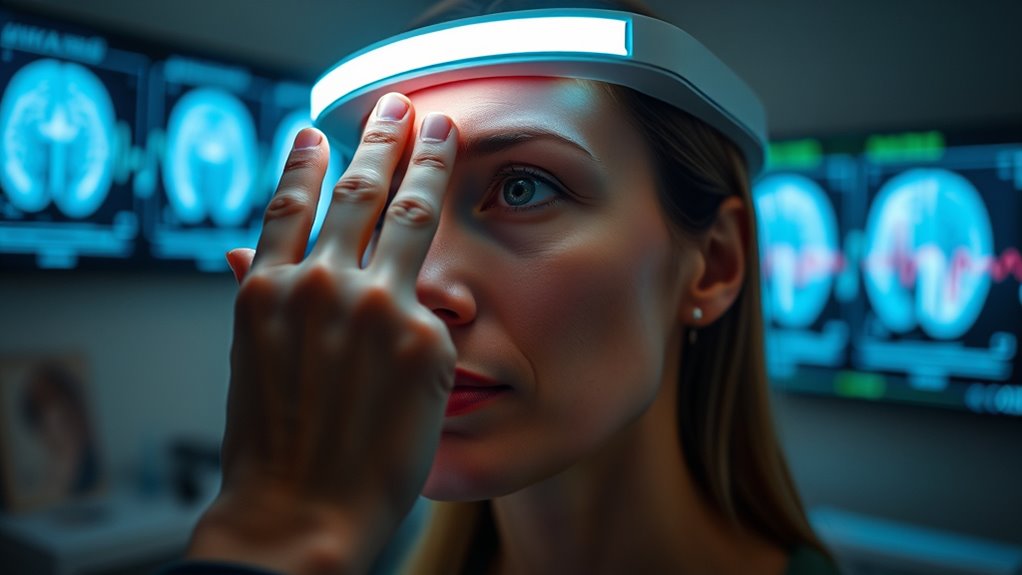EMDR therapy uses guided eye movements or bilateral stimulation to help your brain reprocess traumatic memories. By activating both hemispheres, these movements support neural connections and promote emotional regulation. This process rewires distressing memories, making them less emotional and easier to manage. Unlike traditional talk therapy, EMDR targets how memories are stored, leading to faster relief. If you keep exploring, you’ll discover how this innovative approach can support your healing journey.
Key Takeaways
- Eye movements activate both brain hemispheres, facilitating processing and integration of traumatic memories.
- Bilateral stimulation promotes neural rewiring, reducing emotional charge associated with distressing events.
- EMDR helps reframe negative beliefs by engaging neuroplasticity, leading to emotional regulation and recovery.
- The therapy guides clients through structured steps to desensitize trauma and install positive memories.
- Eye movements support natural brain processing, accelerating trauma resolution beyond traditional talk therapy.
What Is EMDR Therapy and How Does It Work?

EMDR therapy, which stands for Eye Movement Desensitization and Reprocessing, is a structured approach designed to help you process traumatic memories. It leverages neuroplasticity research, showing how your brain can change and rewire itself. During sessions, you’re guided to recall distressing events while engaging in bilateral stimulation, like eye movements. This process promotes emotional regulation by helping your brain reframe traumatic experiences, reducing their emotional charge. EMDR encourages your brain to form new, healthier connections, making it easier to manage distress and anxiety. Rather than just talking about trauma, EMDR works at a neurological level, facilitating adaptive processing. Recent studies highlight the importance of AI safety measures in ensuring ethical and secure therapeutic applications, emphasizing the need for ongoing research and regulation in this evolving field. This makes it a powerful tool for healing emotional wounds and fostering resilience through targeted neuroplasticity.
The Origins and Development of EMDR

The development of EMDR therapy traces back to the late 1980s when psychologist Francine Shapiro noticed that moving her eyes seemed to reduce the distress of troubling memories. This observation sparked a history overview that led to formal research on eye movements and trauma. Shapiro’s work uncovered the therapeutic origins of EMDR, combining elements from various psychological theories. Initially, she tested her approach with trauma survivors, finding significant improvements. Over time, EMDR evolved into a structured therapy that integrates bilateral stimulation with cognitive processing. Its development was driven by a desire to understand how eye movements could facilitate healing. Today, EMDR continues to grow as a validated treatment, rooted in its rich history and ongoing research into trauma recovery. Additionally, the recognition of anime movies and their storytelling techniques has influenced various media, including therapeutic visuals and animations used in trauma therapy.
The Science Behind Eye Movements and Brain Processing

You might wonder how eye movements influence your brain during EMDR therapy. Research shows that bilateral stimulation activates both brain hemispheres, enhancing how your mind processes traumatic memories. Understanding these mechanisms can help clarify why EMDR is so effective in healing emotional wounds. Data-driven strategies like these are supported by scientific studies demonstrating measurable results in trauma recovery.
Bilateral Stimulation Effects
Bilateral stimulation, a core component of EMDR therapy, works by engaging both hemispheres of the brain simultaneously, which helps disrupt distressing memories and enhances processing. This stimulation influences the brain hemisphere communication, activating neural pathways that facilitate emotional regulation and cognitive integration. The stimulation effects promote a state where traumatic memories become less vivid and emotionally charged, allowing you to process them more adaptively. By stimulating both sides of the brain, EMDR reduces the emotional intensity tied to traumatic experiences, making it easier to reframe and integrate those memories. This bilateral approach taps into your brain’s natural ability to heal, harnessing the power of coordinated hemispheric activity to support trauma recovery and emotional resilience. Additionally, understanding cost and budgeting factors can help optimize treatment plans and ensure access to necessary resources.
Brain Hemisphere Activation
How do eye movements during EMDR influence brain processing? They stimulate brain activity across both hemispheres, promoting hemispheric balance. When you move your eyes back and forth, it encourages communication between the right and left brain, which are often out of sync after traumatic events. This bilateral stimulation helps reset and coordinate activity in these hemispheres, allowing your brain to process distressing memories more effectively. By balancing hemispheric activation, EMDR reduces emotional intensity and facilitates healthier information flow. This improved hemispheric communication underpins the therapy’s ability to rewire trauma-related neural pathways. In essence, eye movements act as a catalyst, harmonizing brain activity and paving the way for healing. Antiques, when thoughtfully incorporated into a space, can also serve as a form of sensory stimulation that promotes neural integration and comfort.
Memory Processing Mechanisms
Eye movements during EMDR directly influence how the brain processes and integrates traumatic memories by engaging specific neural mechanisms. These movements activate neural pathways involved in memory processing, facilitating the reorganization of distressing experiences. As you follow the eye movements, your brain begins cognitive restructuring, making it easier to reframe negative beliefs. This process helps break down the emotional intensity tied to trauma, allowing healthier connections to form. The table below highlights key aspects of memory processing during EMDR:
| Neural Pathways | Cognitive Restructuring |
|---|---|
| Facilitate memory integration | Reframe traumatic beliefs |
| Activate hippocampus | Reduce emotional distress |
| Engage prefrontal cortex | Strengthen adaptive responses |
| Promote neural plasticity | Support adaptive learning |
| Enable memory reconsolidation | Foster healing |
Additionally, understanding the underlying Law of Attraction principles can enhance the effectiveness of trauma recovery by aligning positive thoughts with healing outcomes.
The Typical EMDR Therapy Session Process

During a typical EMDR session, you’ll follow a structured process that guides you through remembering and processing difficult experiences. Your therapist’s role is to create a safe environment and guide you through each phase, while your role is to engage with the memories and sensations that arise. Together, you work step-by-step to facilitate healing and integrate new perspectives. Incorporating lucid dreaming techniques can also help individuals become more aware of their internal experiences, which may enhance the effectiveness of trauma processing.
Session Structure Overview
Have you ever wondered what a typical EMDR therapy session looks like from start to finish? Usually, it begins with a brief check-in, where you might practice mindfulness techniques to ground yourself. Your therapist then guides you through identifying specific memories or triggers. During the processing phase, eye movements or bilateral stimulation help you reframe these experiences. You might also discuss medication management if relevant. Between sessions, your therapist could suggest relaxation exercises or mindfulness practices to reinforce progress. Here’s a quick overview:
| Phase | Focus | Techniques Used |
|---|---|---|
| Preparation | Building trust, grounding | Mindfulness techniques |
| Assessment | Selecting targets for reprocessing | Memory recall |
| Desensitization | Processing traumatic memories | Eye movements, bilateral stimulation |
| Installation | Strengthening positive beliefs | Visualization |
| Closure | Stabilizing, relaxation | Breathing exercises |
Additionally, understanding the psychological mechanisms involved in EMDR can enhance your awareness of how these techniques facilitate healing.
Client and Therapist Roles
In a typical EMDR therapy session, both you and your therapist have specific roles that work together to facilitate healing. You are encouraged to share your experiences and feelings openly, which fosters client empowerment. Your therapist guides you through the process using specific techniques, such as guided eye movements or bilateral stimulation, to access and process traumatic memories safely. While you focus on your inner experience, your therapist remains attentive, providing reassurance and adjusting techniques as needed. They create a supportive environment that encourages your active participation. This collaboration helps you regain control over distressing memories and develop healthier perspectives. Ultimately, your role is to engage fully in the process, trusting your therapist’s expertise, and allowing the eye movements to facilitate emotional and psychological healing.
Conditions That Respond Well to EMDR Treatment

EMDR therapy has proven highly effective in treating a range of psychological conditions, especially those rooted in trauma and distress. You’ll find it useful for stress reduction and building emotional resilience. Many clients experience significant relief from anxiety, depression, and PTSD symptoms through EMDR’s targeted approach. It helps reprocess troubling memories, reducing their emotional impact. Trauma processing is at the core of EMDR’s effectiveness, enabling individuals to recover from distressing experiences more rapidly and thoroughly. The following table highlights common conditions that respond well to EMDR:
| Condition | Benefits |
|---|---|
| PTSD | Trauma processing and emotional resilience |
| Anxiety Disorders | Stress reduction and calming effects |
| Phobias | Desensitization and improved coping skills |
Benefits of EMDR for Trauma Recovery

Trauma recovery benefits greatly from EMDR, as its focused approach helps you process and resolve distressing memories more efficiently. By targeting traumatic memories directly, EMDR reduces the emotional impact of trauma triggers that often cause distress long after the event. This therapy strengthens your emotional resilience, enabling you to face difficult feelings without becoming overwhelmed. As you work through traumatic experiences, you learn healthier ways to manage emotional reactions, decreasing avoidance and fear. EMDR’s bilateral stimulation accelerates the healing process, allowing you to integrate memories into your life story more adaptively. Resources and Tools can further support your recovery journey by providing additional guidance and strategies. Over time, you develop a greater sense of control, confidence, and emotional stability, making recovery more sustainable and empowering you to move forward with a renewed sense of hope.
How EMDR Differs From Traditional Talk Therapy

While traditional talk therapy primarily relies on verbal processing and reflection, EMDR takes a different approach by using bilateral stimulation to directly target traumatic memories. Unlike talk therapy, which may focus on understanding the story behind your trauma, EMDR aims to alter the way these memories are stored in your brain. This method challenges neuroplasticity myths by showing how your brain can change and rewire itself through targeted intervention. EMDR also enhances emotional regulation, helping you manage intense feelings more effectively. Instead of solely exploring emotions verbally, you engage your brain’s natural ability to adapt, allowing traumatic memories to become less disturbing. This direct, neurobiological approach sets EMDR apart from traditional therapies, offering a faster path to healing.
Preparing for EMDR: What to Expect

Before your first EMDR session, you’ll learn about the process and what to expect. Your therapist will explain how sessions typically flow and offer practical tips to prepare. Being informed and ready can help you feel more comfortable and confident going in.
Session Overview and Process
During an EMDR session, you’ll start by discussing your current concerns and setting clear goals with your therapist. This helps establish a safe and supportive session environment, allowing you to feel comfortable sharing. The therapist then guides you through specific therapy techniques to access your memories. The process is structured yet flexible, focusing on your readiness and responses.
| Step | What Happens |
|---|---|
| 1 | Discuss current concerns and goals |
| 2 | Establish a safe session environment |
| 3 | Access target memories using specific therapy techniques |
| 4 | Process memories with bilateral stimulation |
| 5 | Reflect on insights and plan next steps |
Practical Preparation Tips
Preparing for an EMDR session involves taking practical steps to guarantee you’re ready and comfortable. Begin by practicing mindfulness techniques to center yourself and reduce anxiety beforehand. Deep breathing exercises or grounding methods can help you stay present and calm. It’s also helpful to make sure you’re well-rested and avoid stimulants like caffeine before your session. Bring any notes or questions to discuss with your therapist. Focus on stress reduction by creating a quiet, comfortable environment for afterward, allowing yourself time to process. Communicate openly with your therapist about any concerns or triggers. This preparation helps you feel more in control, making the session more effective and less overwhelming. Being mindful and proactive sets a positive foundation for your EMDR healing journey.
Success Stories: Real-Life Healing Through EMDR

Have you ever wondered how EMDR therapy can transform lives? Many people have experienced remarkable healing, overcoming trauma and anxiety with this approach. Clients often share stories of reclaiming peace through techniques like mindfulness and anxiety management during sessions. These success stories highlight how EMDR helps reprocess painful memories, leading to lasting relief.
| Before EMDR | After EMDR |
|---|---|
| Struggles with flashbacks | Reduced flashbacks and triggers |
| Overwhelmed by anxiety | Increased calm and control |
| Difficulty trusting others | Restored confidence |
| Feeling stuck in past pain | Moving forward with resilience |
Finding a Qualified EMDR Practitioner

Finding a qualified EMDR practitioner is a crucial step in your healing journey, as not all therapists are trained in this specialized method. You should look for someone with specific therapist qualifications in EMDR therapy, ensuring they have completed accredited training programs. Check their experience working with trauma and their familiarity with treatment facilities that specialize in EMDR. A qualified practitioner will guide you safely through the process, tailoring sessions to your needs. Don’t hesitate to ask about their credentials, including certifications and years of experience. A reputable therapist will prioritize your comfort and safety, making sure you’re working with someone who understands the nuances of EMDR therapy and operates within reputable treatment facilities.
Frequently Asked Questions
How Long Does an Average EMDR Therapy Course Last?
The length of an EMDR therapy course varies depending on your needs, but typically, therapy duration ranges from 6 to 12 sessions. You’ll notice treatment milestones as you process traumatic memories and reduce distress. Each session usually lasts about 60 to 90 minutes, and your therapist will tailor the treatment plan based on your progress. Consistency and openness help guarantee you reach your healing goals efficiently.
Are There Any Risks or Side Effects Associated With EMDR?
You might think it’s smooth sailing, but it’s wise to know potential side effects and risk factors. EMDR therapy generally is safe, yet some people experience headaches, dizziness, or emotional discomfort afterward. These side effects are usually temporary. While serious risks are rare, it’s crucial to work with a trained therapist who can monitor your response and minimize any adverse effects, ensuring a safe healing journey.
Can EMDR Be Combined With Other Psychotherapy Methods?
You can definitely combine EMDR with other psychotherapy methods, as many practitioners use integrative approaches. These complementary therapies, like CBT or mindfulness, often enhance treatment outcomes. By blending techniques, you address different aspects of trauma more effectively. Always discuss your options with your therapist to guarantee the combined approach suits your needs and is safe. This personalized method can provide a thorough path toward healing and recovery.
Is EMDR Effective for Children and Adolescents?
You might wonder if EMDR is effective for children and adolescents. Research shows it can help reduce child anxiety and strengthen adolescent resilience. As a therapist, you’ll find that kids often respond well to EMDR, experiencing improved emotional regulation. Its structured approach suits young people, making it easier for them to process traumatic memories and build resilience, leading to healthier development and coping skills.
How Do I Find a Licensed EMDR Therapist Near Me?
To find a licensed EMDR therapist near you, start by searching online directories like Psychology Today or TherapyDen. These platforms allow you to filter by location, specialties, and credentials. You can also ask your primary care provider for recommendations or check local mental health clinics. Make sure to confirm that the therapist is licensed and experienced in EMDR therapy to ensure you receive quality care tailored to your needs.
Conclusion
Ready to take control of your healing journey? EMDR therapy offers a powerful, evidence-based way to process trauma and regain your peace. With skilled guidance, you can transform painful memories into newfound strength. Don’t you deserve a brighter, trauma-free future? If you’re considering EMDR, take the first step today—your mind and body will thank you for it. Healing is possible, and you don’t have to do it alone.










